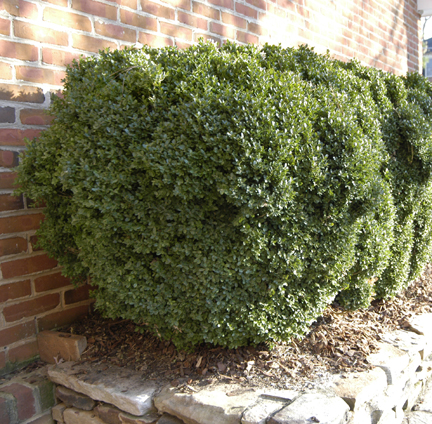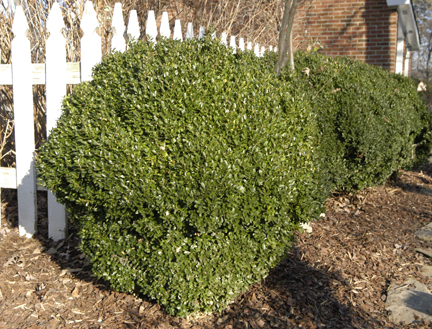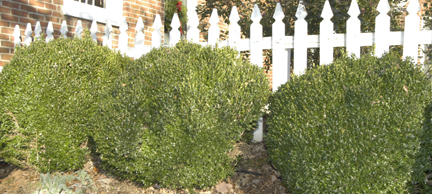
Boxwoods Anchor the Winter Garden
Boxwoods Anchor the Winter Garden



 During your next mid-winter stroll through the garden, you’ll notice that boxwoods really come into their own during this time of year. Boxwoods anchor the winter garden by providing green structure when most shrubs have dropped their leaves and show bare limbs. These evergreen shrubs are the backbone of most formal gardens and are highly prized for the backdrop they provide for both traditional and exotic gardens.
During your next mid-winter stroll through the garden, you’ll notice that boxwoods really come into their own during this time of year. Boxwoods anchor the winter garden by providing green structure when most shrubs have dropped their leaves and show bare limbs. These evergreen shrubs are the backbone of most formal gardens and are highly prized for the backdrop they provide for both traditional and exotic gardens.
Often, we don’t notice boxwoods until the prima donnas of the garden have been laid down by frost or snow. Once the flowering annuals and perennials have been nipped by Jack Frost, boxwoods finally get some attention in the garden. Boxwoods anchor the winter garden and should be considered for every American garden.
Boxwoods are part of the American landscape tradition. Mount Vernon, the White House, the buildings at Colonial Williamsburg, and most antebellum southern gardens feature formal boxwood plantings.
The American Boxwood Society reports boxwoods were first used in American gardens on Long Island in 1653 when shrubs were brought across the Atlantic Ocean from Amsterdam for planting.
Early twentieth century urban landscapes and late twentieth century perennial borders made extensive use of boxwoods for structure and as an evergreen backdrop. Check just about any plant list and you will find boxwood listed somewhere.
One of my earliest memories is playing hide-and-go-seek inside several huge boxwood shrubs at my grandmother’s house. Left un-pruned, boxwoods can reach enormous sizes.
American Box (Buxus sempervirens) is the shrub most of us are familiar with from plantings put around homes in the 1900s. You’ve probably also seen many specimens of English Box (Buxus sempervirens ‘Suffruticosa’), a low compact form of boxwood used in formal plantings like those at Colonial Williamsburg.
There are 115 commercially grown cultivars and species of boxwood available for today’s garden, with most modern cultivars having more disease resistance than their American and English Box ancestors.
Boxwoods have been overused in some gardens because they are relatively easy to care for and give the gardener little trouble.
They like partial shade but will survive full sun. Boxwoods prefer a soil with lots of organic matter in them, but do amazingly well in Georgia clay if soil conditioner is added at planting.
Soils must drain properly no matter what the composition, as boxwoods do not tolerate wet feet. A ph balance of 6.5 to 7.2 is preferred. Fertilization is needed only when the plant fails to show new growth in late spring, or when the bottom leaves turn bronze or yellow in the winter.
Slow release fertilizers can help gardeners avoid burning the shallow roots of a boxwood shrub and two or three inches of mulch helps conserve moisture in the soil. Drought conditions require a deep watering of the soil around the shrub, preferably with a soaker-type hose or other slow release mechanism.
Where your average gardener usually goes astray with boxwood is in the pruning. A boxwood shrub should never be sheared (or “meatballed,” as Walter Reeves would say).
If you use a trimmer to prune your boxwood shrub, you will end up with green leaves only a few inches deep around the exterior of the shrub. In addition to looking unnatural, this condition is also unhealthy for the shrub as it promotes fungus and disease.
Rather, the limbs of the boxwood should be thinned (or plucked) so that light can penetrate the plant and the green leaf zone can extend up to 12 inches into the plant. The last two inches of twigs should be broken off or clipped in such a fashion as to open up the canopy of the plant.
Like a barber thinning out or feathering someone’s hair, the gardener should reach into the shrub and break off a two to four inch stem of the plant. Repeat all over the plant to the point where you have good air circulation and light penetration into the shrub’s interior.
A loose exterior texture is desired. Rather than having a manicured and sheared look, the boxwood shrub is happier with a feathered green edge around the perimeter of the shrub that allows light to penetrate the interior.
This feathered edge also adds a cloudlike appearance to the shrub, which is more in keeping with mother natures design for the plant.
We hope that, with these tips, you can enjoy boxwood on your next walk through your garden.


